UPDATE (09.10.2022): Post substantially revised to reflect v1.0.0 v0.8.0 of the enhanced NYC subway.
Welcome back to my ongoing NYTIP series! In my last post, I discussed ways to improve the Broadway and Queens Boulevard trunk lines. In this post, I will discuss the Eastern Parkway trunk line served by the 2, 3, 4, and 5 lines in Brooklyn.
Note: Click any image to enlarge.
[Fig. 1] Snippet of the NYC Subway Map showing the Eastern Parkway trunk line and branches.
The Eastern Parkway trunk line runs from Borough Hall to Crown Heights – Utica Avenue in Brooklyn. The 2 and 3 lines run local, while the 4 and 5 lines run express. West of Franklin Avenue station, the trunk is already “de-interlined” since 2 and 3 trains from Manhattan’s west side run local and 4 and 5 trains from Manhattan’s east side run express. East of Franklin Avenue station, the 2 and 5 diverge via the Nostrand Avenue branch, while the 3 and 4 continue via Eastern Parkway; the 3 runs local to New Lots Avenue, while the 4 runs express to Utica Avenue.
The current pattern constrains capacity on the 2, 3, 4, and 5 lines due to a single junction – the notorious Rogers Avenue Junction (also called Nostrand Junction):
[Fig. 2] Nostrand Junction. Source: Regional Plan Association’s Save our Subways publication.
As originally designed, Nostrand Junction had local service splitting into two branches (one via Nostrand Avenue and one continuing east on Eastern Parkway) and express service continuing via Eastern Parkway to the Utica Avenue terminal. Under the current pattern, the 5 express crosses the local tracks at grade to access the Nostrand Avenue branch. Due to this merging conflict, as well as the Flatbush Avenue – Brooklyn College terminal’s inefficient design (it wasn’t supposed to be a terminal), several peak-hour 2, 4, and 5 trains start or end at Utica Avenue or New Lots Avenue. This causes even more conflicts.
The Regional Plan Association suggested sending 2 and 3 trains via Nostrand Avenue and 4 and 5 trains via Eastern Parkway, but there’s a problem – this pattern still requires either the 4 or the 5 to merge with the 2/3 briefly to serve the local stops east of Franklin Avenue.
Thus, operational changes alone are insufficient. Fixing Nostrand Junction requires a capital investment; because the subway transitions from single-level to bilevel at Nostrand Junction, the scope of work required is not trivial.
In a previous version of this post, I suggested short track connections on each level to address this conflict:
[Fig. 3] Modified Nostrand Junction with new track segments. The original track map belongs to vanshnookenraggen.
However, I learned that MTA studied various alternatives for Nostrand Junction at length; the linked 2009 study examined two alternatives that were selected from a field of 7 in a previous 1993 study. Since the image above does not reflect the two alternatives advanced by MTA, I will no longer consider it.
Instead, let us consider the two alternatives advanced by MTA. Which one is best for increasing service and mitigating delays on the 2, 3, 4, and 5 lines?
Option 1: Implement “Alternative 4” – new switches
[Fig. 4] Overview of Option 1.
Option 1 (Alternative 4 in the Nostrand Junction study) proposes two new switches near Nostrand Avenue station. With these switches, 2 and 3 trains would serve the Nostrand Avenue branch while the 4 and 5 continue eastward on Eastern Parkway. As applied to NYTIP, the 4 would run local east of Franklin Avenue station and extend to East New York – New Lots Avenue station at all times. The 5 would run express to Crown Heights – Utica Avenue station. Trains no longer cross each other at grade, significantly reducing delays.
While Option 1 is the simplest way to address Nostrand Junction, it results in limited operational flexibility. If the 4 or 5 run via Nostrand Avenue, or if the 2 or 3 run via Eastern Parkway (say, due to construction or emergency reroutes), trains would still cross each other at grade as they do today, causing delays.
Option 2: Implement “Alternative 6” – full grade separation
[Fig. 5] Overview of Option 2.
Option 2 (Alternative 6 in the Nostrand Junction study) converts Nostrand Junction into a “fully-flexed” – or grade-separated – junction. It eliminates almost all of the existing merging conflicts at Nostrand Junction. Eastbound, trains on either the local or express track can access the Nostrand Avenue branch. Trains on the local track can also continue via Eastern Parkway local, while trains on the express track can go local or express on Eastern Parkway. Westbound, the Nostrand Avenue branch meets the Eastern Parkway local track. An existing switch allows Eastern Parkway locals to switch to the express track without interfering with trains from Nostrand Avenue. West of Franklin Avenue, trains could run local or express from either track.
Option 2 offers more operational flexibility than Option 1 since it allows more routing options. Even so, the service pattern that maximizes delay reduction is still a form of de-interlining; therefore, as applied to NYTIP, the proposed service pattern would be the same as in Option 1.
The Nostrand Junction study suggested that Option 1 (Alternative 4) would cost over $343 million – or nearly $474 million in 2022 dollars – and take 3 1/4 years. Option 2 (Alternative 6) would cost nearly $1.6 billion – over $2.2 billion in 2022 dollars – and take approximately 6 years. If MTA found a way to reduce both the cost and the timeline for Option 2, this would be the superior option. However, owing to the significant cost and time difference between the two options – even after taking potential cost and schedule controls into account – I am selecting Option 1 for v0.8.0 of the enhanced NYC subway.
The service plan for v0.8.0 of the enhanced NYC subway would provide 2/3 service at a combined 23-24 trains per hour (TPH). Due to a flat junction north of 135th Street station in Manhattan, as well as rolling stock availability, running more TPH is not possible – yet. The “ideal” pattern would split 2 and 3 service evenly – i.e. 12 TPH each. However, Option 1 would make the 3 almost entirely contiguous with the 2. Given both this and the 2 line’s longer length, the 2 would run more frequently than the 3 during peak hours. (The 2 and 3 would run at the same frequency off-peak, however.)
Implementing Option 1 requires addressing a second issue. The Flatbush Avenue – Brooklyn College terminal, as a stub terminal with no tail tracks, can only handle about 20 TPH; this is the current peak-hour service level on the Nostrand Avenue branch. Therefore, to increase service, fixing Nostrand Junction alone isn’t enough – one must fix the Brooklyn College terminal itself.
Required capital investment: construct tail tracks past Flatbush Avenue – Brooklyn College station.
[Fig. 6] Overview of the Flatbush Avenue – Brooklyn College improvement.
The proposed tail tracks are long enough to store up to 6 full-length trains, or 4 full-length trains if the station is operated as a relay terminal. The tails would increase capacity on the 2 and 3 lines, ensuring that they would not have to foul the improved Nostrand Junction. The tails would also take some pressure off of Livonia Yard – the only storage yard for numbered-line trains in Brooklyn.
The Bottom Line
The proposed changes outlined above would affect 2, 3, 4, and 5 service. The table below shows current frequencies and proposed frequencies under NYTIP (in minutes) for each of these lines.
| Service | Current Service (Weekday Peak/Weekday Off-Peak/Weekend) | Proposed NYTIP Service (Peak/Off-Peak) |
| 2 | 5 / 8 / 8 | 4.5 / 6 |
| 3 | 6 / 8 / 12 | 6 / 6 |
| 4 | 4 / 8 / 8 | 4 / 6 |
| 5 | 4.3 / 8 / 12 | 4 / 6 |

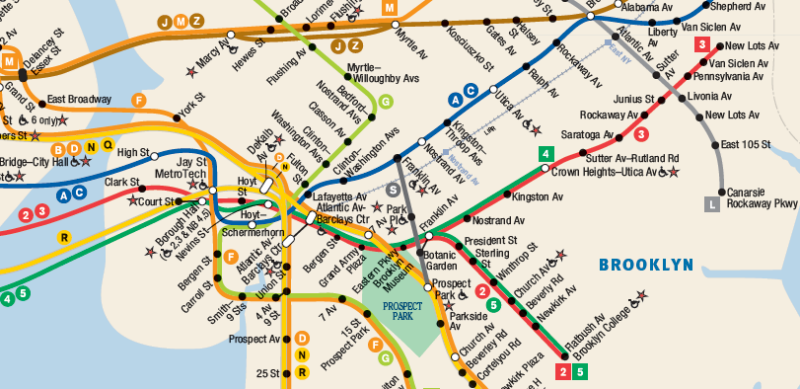
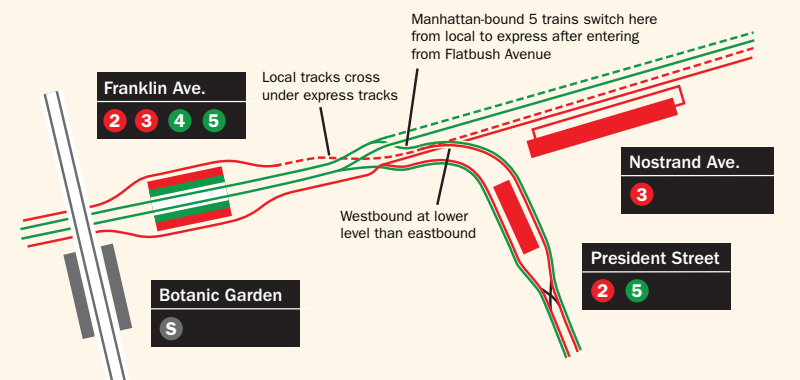
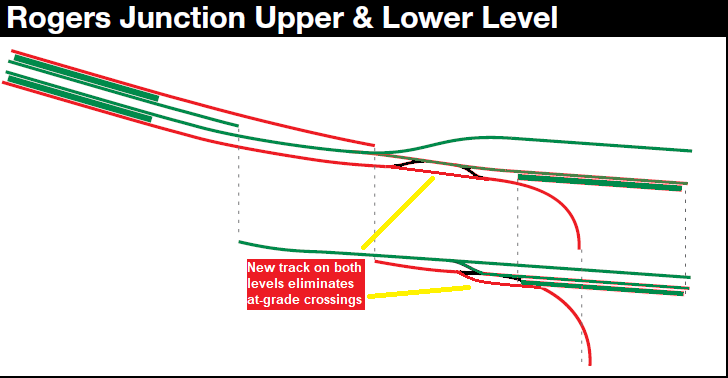
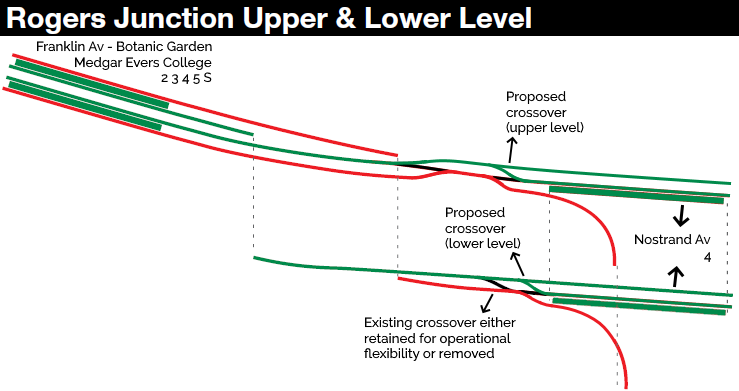
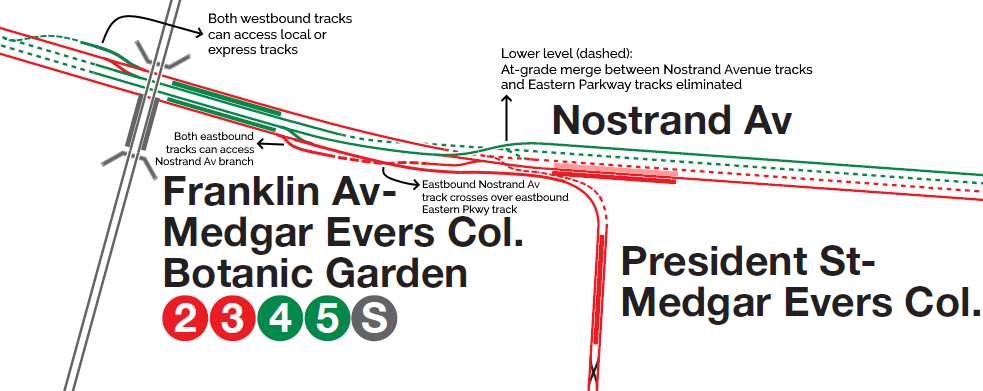
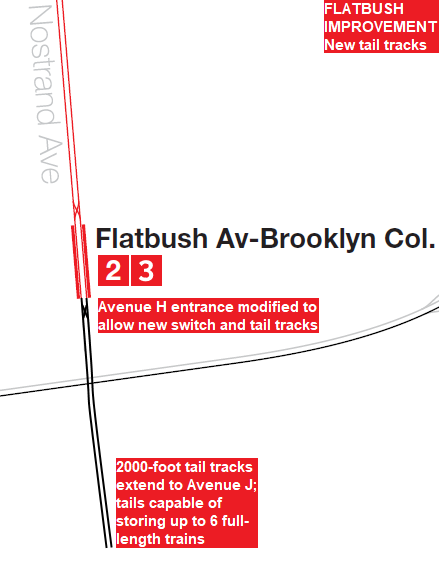
Better:
(2) To New Lots via Express
(3) To Crown Heights-Utica via Express
(4) To Flatbush via Local
(5) To Flatbush via Local
(2)/(3) Express, (4)/(5) Local
A 2/4 swap would still cause trains to cross each other at grade. You’d have to transform Rogers into a network of flying junctions, and you’d still have conflicts unless you retain 2/3 local, 4/5 express.
A Gooder Idea is This:
(2) To Crown Heights-Utica
(3) To New Lots
(4) To Flatbush
(5) To Flatbush
(2)/(4) Swap. (2) is rerouted via (4) to Utica, while (4) goes via (2) to Flatbush to Provide more service.
Good solution for Rogers Jct. The fact that so many are recognizing this problem, there is hope that the MTA can spend money on installing the additional switches needed.
Overall, there should be many more 2 trains than 3 trains, since 2 trains reach the NE Bronx, and the 3 trains only reach two unique stations in Harlem.* So assuming that the majority of trains (but not all) along the 7 Ave IRT express can be turned at Flatbush Ave, all 2 trains should go to Flatbush Avenue. Furthermore, all trains that go to Flatbush Avenue should be 2 trains. The few additional trains that can’t fit at Flatbush Ave should be 3 trains to New Lots.
2 train to Flatbush (including more 2 trains than currently assigned)
3 train to New Lots
4 train to New Lots (since 5 currently turns at South Ferry for good parts of the service day, it would be simpler if 4 ran the whole way at all times).
5 train to Utica
*Since there are only two unique stations, the 3 train should be a part-time train and the two northern stations should be part time and serviced by bus along Lenox Ave at all times other than rush hour.